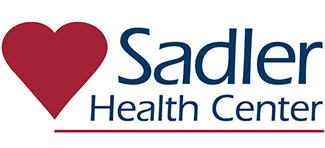The initial phase of Pennsylvania’s COVID-19 vaccine rollout appears to include far more people than health care providers were led to believe, exacerbating the shortage of vaccine doses both locally and across the state.
Pennsylvania expanded eligibility for the initial phase — dubbed Phase 1A — of its vaccine roll-out plan two weeks ago, at the behest of the federal government. At that time, then-Secretary of Health and Human Services Alex Azar had told states that vaccine reserves would be released from federal stockpiles to cover the expanded population.
Those reserves did not exist as the Trump administration portrayed them. But Pennsylvania’s expanded vaccine rules remain, and it is not entirely clear how many people are actually covered by the expanded initial phase, although it is certainly more than was initially portrayed.
“I think the cat’s out of the bag at this point,” Cronin said, meaning it will be nigh impossible for Pennsylvania or any other state to roll back the eligibility expansion. “Pennsylvania has a really robust vaccine plan, but it only works if what you’re being told by the federal government is the truth.”
“We thought that we were going to have an expanded supply,“ Wolf said. “That was wrong. They weren’t expanded. In fact it turned out there was no stockpile.”
With a census population of just over 12.8 million people, the initial estimate for the expanded Phase 1A of 3.5 million would mean a little over a quarter of Pennsylvania’s population would be eligible.
Penn State Health has been inundated with calls since the Phase 1A guidelines were announced, with Milton S. Hershey Medical Center and other Penn State-run facilities no longer accepting phone appointments for vaccination due to the overload.
Sadler isn’t alone. In many parts of the state, federally qualified health centers, which receive additional federal assistance for helping under-served populations, have become the primary conduits for vaccination, said Eric Kiehl, policy director for the Pennsylvania Association of Community Health Centers.
The phase also includes a broad range of health care personnel, including dentists and chiropractors. Data from the federal Bureau of Labor Statistics shows that health care practitioners and technicians number just over 406,000 workers in Pennsylvania. The health care support labor sector includes another 336,000 people, many of whom also stand to be eligible under Phase 1A.
The initial phase also includes people with certain health conditions that increase their risk from COVID-19, with some of those conditions encompassing large portions of the population. Obese people, defined as those with a body mass index of 30 or more, are included in this group.
Even assuming overlap between those categories, it’s possible that Phase 1A may cover the majority of the population in some areas. In her home area of Bethlehem and Allentown, Cronin estimated that 50% of the population is likely eligible.
“[The plan] was not what it is right now,” Cronin said. “That blindsided everyone when Alex Azar came out with that.”
“We’re not receiving enough doses of vaccine to meet the needs of Pennsylvania,” Wolf said.
The bottleneck most likely is the result of Pennsylvania’s decentralized public health system; only a handful of larger counties and municipalities in the state have health departments. Outside of these, the state has to allocate resources to clinics and hospitals that aren’t necessarily communicating with each other.
Cancellations of vaccine appointments are also a byproduct of the rush, Kiehl said, as patients book appointments at several places, unsure of availability, and then show up to the first one.
The most critical thing to do at this point, Cronin said, is to “get it out as fast as you can.” If doses are taken out of cold storage and opened, but patients don’t show, “then go out on the street and say ‘do you want your COVID vaccine?’ We can’t waste them.”
Covid Vaccine 5
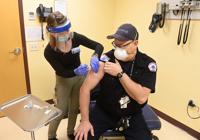
Eric Coldren, a paramedic at Cumberland Goodwill EMS in Carlisle, receives the first of two Moderna COVID-19 vaccine injections from Jamie Cunningham, a registered nurse case manager, at Sadler Health Center.
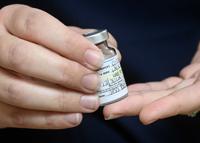
Jessica Barrett, a licensed practical nurse clinical manager at Sadler Health Center in Carlisle, prepares to distribute the Moderna COVID-19 vaccine on Dec. 30 to members of Cumberland Goodwill EMS.
Covid Vaccine 2

Jessica Barrett, a licensed practical nurse clinical manager at Sadler Health Center, right, gives follow up care instructions for the Moderna COVID-19 vaccine to Siobhan Reeser of Cumberland Goodwill EMS.
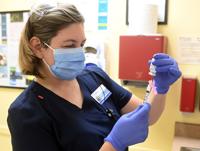
Jessica Barrett at Sadler Health Center prepares an injection of Moderna COVID-19 vaccine for a member of Cumberland Goodwill EMS.
Covid Vaccine 4

Michael Mayberry, a emergency medical technician at Cumberland Goodwill EMS in Carlisle, received the first of two Moderna COVID-19 shots from Jessica Barrett at Sadler Health Center.
Covid Vaccine 6
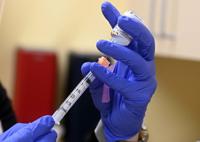
Jamie Cunningham, a registered nurse case manager at Sadler Health Center in Carlisle, prepares a shot of Moderna COVID-19 vaccine in December.
